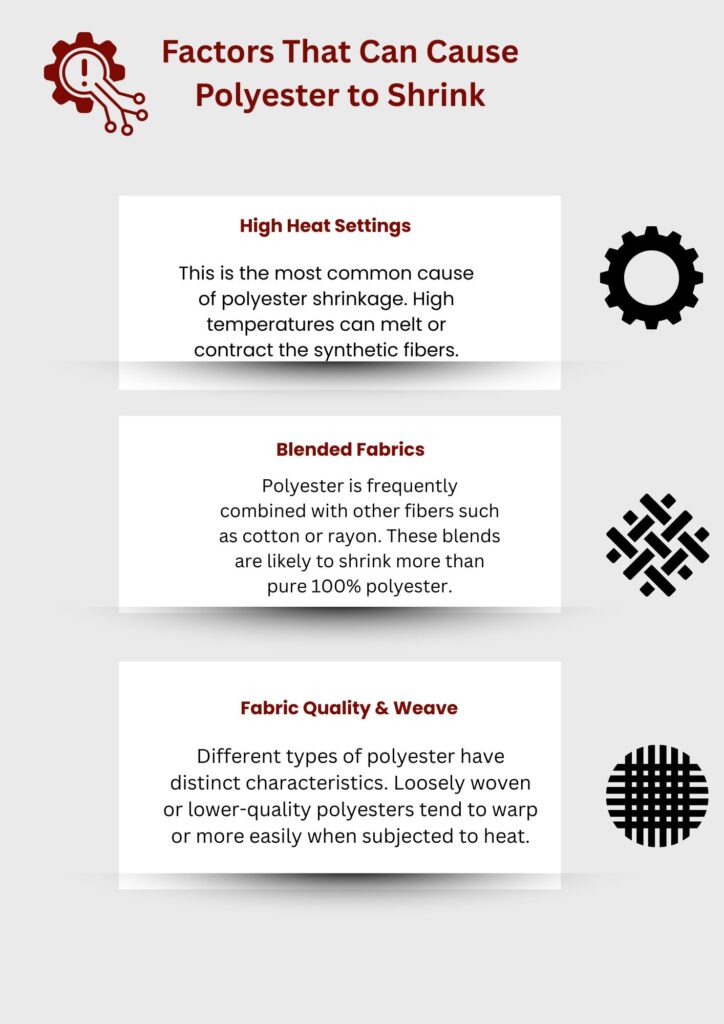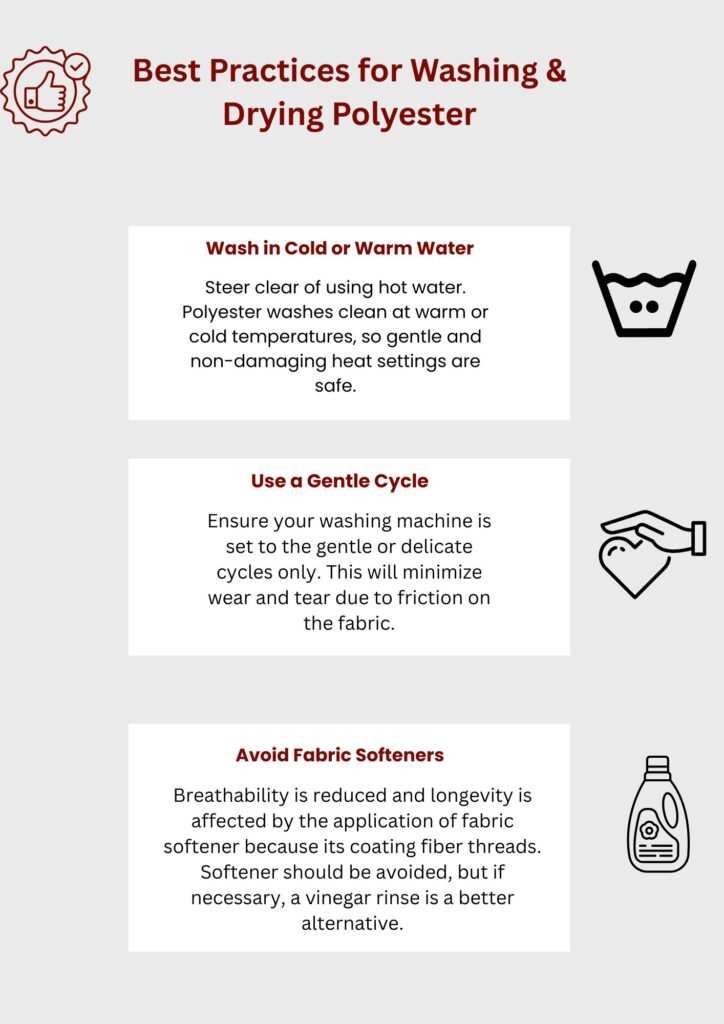Introduction
Polyester is a synthetic textile constructed from polymers of petroleum. It is well-known for possessing durability, resistance to wrinkles, and drying quickly. It is also used in clothing, upholstery, curtains, and sportswear such that it has become one of the household textile staples in our society. It is favoured by both consumers and manufacturers for its ability to retain shape and color.
Though, one common question arises: does polyester shrink if dried in a tumble dryer? Many people tend to err on the side of caution when it comes to drying their polyester clothes because of the potential damage they may cause. While this fear is reasonable, whatever the damage may be, there is a scientific explanation for it. This article thoroughly investigates the matter of whether polyester actually shrinks in the dryer and how best to maintain it.
Does Polyester Shrink in the Dryer?
The Straight Answer
Contrary to cotton and wool, polyester is not as prone to shrinking. Still, it is not immune to damage. Excessive heat, such as that from a dryer set too high, can lead to deformation or melting.
Why Polyester Behaves Differently
The primary reason polyester resists shrinkage is eld because polyesters are thermoplastic copolymer fabrics. Materials that thermoplastic rubbers and fabrics are made of can be repeatedly melted and hardened upon heating and cooling. Unlike many other fabrics, polyester possesses a high melting temperature of about 482°F (250°C), which is why it does not easily shrink unless extremely heated.
In comparison, natural fibers such as cotton and wool swell when heated and scrubbed. They seized to behave innocuously, as they are significantly different from polyester, which is a synthetic fibre.
Factors That Can Cause Polyester to Shrink
Though polyester is a strong fabric, there are many ways it can shrink, particularly in a tumble dryer.

High Heat Settings
This is the most common cause of polyester shrinkage. High temperatures can melt or contract the synthetic fibers. After the fabric undergoes deformation due to heat, recovering from such damage is virtually impossible.
Blended Fabrics
Polyester is frequently combined with other fibers such as cotton or rayon. These blends are likely to shrink more than pure 100% polyester. If the cotton portion shrinks, it can warp the entire garment.
Fabric Quality & Weave
Different types of polyester have distinct characteristics. Loosely woven or lower-quality polyesters tend to warp or more easily when subjected to heat. As with other fabrics, thinner polyesters must be handled with care due to their delicate nature.
Repeated Exposure to Heat
Repeated drying at elevated temperatures will weaken polyester fibers over a prolonged period. Continuous exposure to heat—even in the absence of immediate shrinkage—will compromise the structural integrity of the fabric.
How to Prevent Polyester from Shrinking in the Dryer
Proper maintenance procedures of polyester aids to retain its form and increase its lifespan.
Use Low or Medium Heat Settings
Always steer clear from excessive heat. Use a medium or low heat setting on your dryer. Modern dryers often come with a “delicate” or “synthetic” setting—those work well with polyester.
Remove Clothes While Slightly Damp
Take polyester clothes out of the dryer when they are still a bit damp. Let them finish drying in the air. This minimizes the exposure to heat and prevents damage.
Check Care Labels
As with all caring instructions, manufacturers have a reason for providing drying instructions. Always check the care label as some blends of polyester have special requirements.
Use Dryer Balls
Due to their ability to shorten drying time and balance heat distribution, dryer balls lower the possibility of shrinkage. They also minimize static and wrinkles.
Consider Air Drying
For some more concerned about heat damage, like lingerie or polyester sportswear, air drying completely is optimal.
Can You Unshrink Polyester?
Regrettably, unshrinking polyester is a challenging task. Although there are a few methods you may attempt, the outcome is not always certain.
Soaking in Lukewarm Water with Conditioner
Combine lukewarm water with several drops of hair conditioner or baby shampoo. Soak the garment for 15–20 minutes. This relaxes some of the fibers which may aid in reshaping the fabric.
Gently Stretching While Damp
Once you have finished soaking, gently stretch the fabric by hand. Lay the garment out on a towel, pinning it down flat to allow it to dry. This may help recover some of the shape.
Using a Steamer or Iron (With Caution)
You can perform gentle steaming on the garment and stretch it by hand, however, do not apply excessive heat. Always place a cloth barrier between the steam iron and the fabric.
Polyester vs. Other Fabrics: Shrinkage Comparison
Let’s see how polyester compares with common fabrics in terms of shrinkage.
Cotton
Cotton shrinks easily, especially during the first few washes. Unlike polyester, cotton absorbs water and changes shape when dried at high temperatures.
Wool
Wool is prone to shrinking even from the most gentle treatment, such as lukewarm water and low cycles. To prevent further damage, always dry wool garments flat and never use a dryer.
Nylon
Nylon behaves similarly to polyester, although it is slightly more delicate. High temperatures can cause melting or shrinkage, therefore care must be exercised.
Rayon
Rayon is more shrink resistant than polyester, as it is a semi-synthetic fabric that strongly responds to heat and moisture.
Common Myths About Polyester and Shrinking
Addressing the misunderstandings surrounding maintenance of polyester lets us clarify several myths that create confusion.
“Polyester Never Shrinks” — False
This remains a widespread myth. While blends of polyester are prone to shrinkage with heat, the fabric itself is relatively dryer-friendly.
“All Synthetic Fabrics Behave the Same” — Not True
With regard to wash and wear cycles, each polymer, including nylon, spandex, acrylic and even polyester possesses unique thermoplastic properties. While polyester is more durable against heat, it behaves more like a natural fiber than other synthetics.
“You Can Tumble Dry Polyester at Any Temperature” — Dangerous
Avoiding all extreme temperatures when drying is crucial as it could result in damage by melting, warping or even shrinking. Following care labels is most recommended.
Best Practices for Washing & Drying Polyester
Observe these recommendations if you wish to prolong the lifespan of your polyester clothing.

Wash in Cold or Warm Water
Steer clear of using hot water. Polyester washes clean at warm or cold temperatures, so gentle and non-damaging heat settings are safe.
Use a Gentle Cycle
Ensure your washing machine is set to the gentle or delicate cycles only. This will minimize wear and tear due to friction on the fabric.
Avoid Fabric Softeners
Breathability is reduced and longevity is affected by the application of fabric softener because its coating fiber threads. Softener should be avoided, but if necessary, a vinegar rinse is a better alternative.
Turn Clothes Inside Out
To shield your garments from surface abrasion damage and color fading, Turning the garment inside out before washing or drying is crucial.
Conclusion
Having delved into the myths, care considerations, and science behind polyester, it is now time to address the burning question at hand: Does polyester actually shrink when subjected to tumble drying? Indeed, it does—but only under very unique and extreme circumstances. Tumble dryers do not only pose a risk of damaging polyester fabrics; such appliances could also be where materials would be subjected to the highest heat and most severe damage. Although polyester is quite the durable and heat resistant fabric, it can certainly sustain some damage, including shrinkage, melting, or warping, when exposed to extremely high temperatures for prolonged periods of time.
As with other synthetic fabrics, polyester behaves quite differently than natural fibers such as wool or cotton. It does not heat easily and holds shape far better under heat due to its thermoplastic nature. The risk of shrinkage occurring is minimal provided the garment remains of good quality and properly maintained. Real trouble begins, however, when excessive heat, poor blend of fabrics, or misuse come into play. As such, your habits are what truly matter rather than the material in question.
FAQs
Poor manufacturing processes or overheating may lead to some shrinking, but good-quality polyester will not shrink with normal drying settings.
Under 220°F (104°C), polyester stays in one piece, though it will start softening. Its melting point is 482°F (250°C), which is well over any dryer temperature but still problematic if sustained over long periods.
High heat exposure can be pernicious, but not all the damage is immediately visible. Long-term consequences can occur from high temperatures—even within low- and mid-range settings.
Label permitting, it is safe to put polyester in the dryer provided low heat is used and clothes are taken out before they dry completely to avoid full dry cycles.


